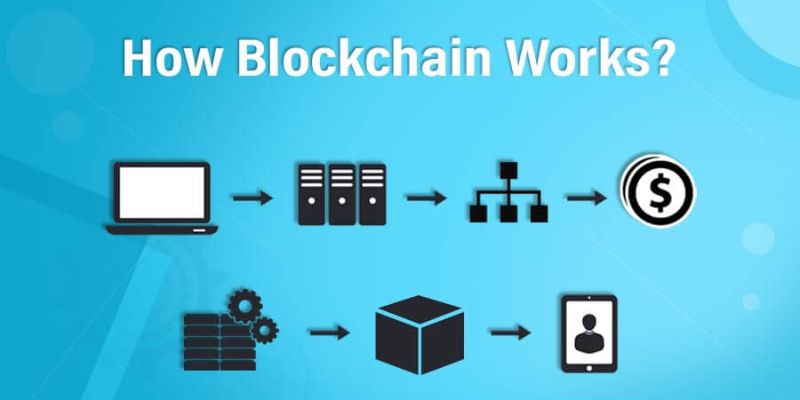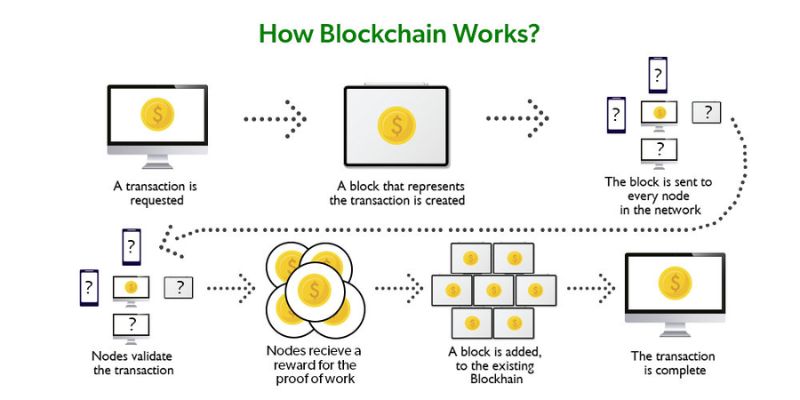Blockchain Demystified: Unpacking the Tech Behind the Buzz
Ever wondered how does blockchain work? Let’s dive straight into the heart of this cutting-edge tech! We strip away the complex jargon to lay bare the nuts and bolts of blockchain. It’s not just digital cash; it’s a revolutionary way to track exchanges. From the core principles driving the system to the cryptographic magic keeping it secure, a clear picture forms. We’ll explore the cunning architecture and the shared ledgers. Plus, we tackle blocks, nodes, and the intricate art of consensus. By the end, even smart contracts won’t seem so daunting. Ready to get the inside scoop on blockchain? Buckle up, and let’s get started!
Understanding the Backbone of Blockchain Technology
The Core Principles and Fundamentals of Blockchain
Think of blockchain like a digital magic notebook. Everyone has a copy. When someone writes in the book, everyone’s book updates with that note. That’s how blockchain lets us share info safely. Cool, right? Now, let’s break down some of the bits and parts that make it tick.
First off, blockchain is like a chain of blocks; no kidding! But these aren’t your kid’s building blocks. Each one holds a bunch of transactions. Think of a transaction like promising your friend your bike for their skateboard. Once we make that promise, it’s written in a block.
Now, to the interesting stuff. These blocks are special because they lock in place. You can’t just rub out an entry. It’s secure like a locked diary. That’s the blockchain principle called “immutability.” Once you add to it, you can’t change it.
Every block has its own secret code, called a “hash,” which is super unique. Kinda like your own secret handshake. And each block’s secret handshake depends on the last block, creating a linked chain that’s tough to mess with.
Understanding blockchain isn’t whole without talking about “decentralization.” This means no single person is in charge. It’s a team effort! When it comes to security, imagine a team where everyone’s keeping an eye on each other. So if someone tries to cheat, bam — they’re caught!
How Cryptographic Hash Functions Safeguard the Network
Afraid of the word “cryptographic”? Don’t worry. It’s just a fancy term for how blockchain makes our stuff safe. It’s like your personal notes becoming a secret code. Even if someone snoops, they won’t understand.
Blockchain uses something called the SHA-256 algorithm, which is a fancy lock for our blocks. When we create a block, SHA-256 turns our info into jumbled-up letters and numbers. It’s so mixed up, no one can go back to the start from the end.
Let’s say you sign your name in the ledger. SHA-256 scrambles it into a hash. This keeps your name safe from nosey parkers. Every transaction, every block, every scribble gets this treatment. That’s one tough security guard, right?
Nodes are the guardians of our blockchain. These are computers all over the world working together. They speak the same secret code language, making sure everything matches up. When one block is added, all the nodes take a peek. If they nod and say, “Yep, that’s cool,” we’re good to go!
In short, the combo of unique block codes and worldwide node guards makes our blockchain a safe place. No single person can mess with it. It’s a group job to keep it straight. That’s blockchain for you – a smart way to keep our deals and promises locked in rock-solid.
So, remember our digital magic notebook? It’s not magic after all! It’s just some nifty tricks and a gang of computers making sure our stuff stays ours. And that, my friends, is the backbone of blockchain technology.
An In-Depth Look into Blockchain Architecture
Assembling Blocks and Transactions in a Decentralized Ledger
Imagine a book where you write down every trade you make. Now, make it digital and let everyone help write this book. That’s blockchain! Each “page” of this book is a “block.” A block carries a bunch of trades, or “transactions.” It’s like a page full of deals ready to be sealed. Think of a transaction as saying, “Alex gave two coins to Jordan.” Simple, right?
Every block is special. It has a unique code, a “cryptographic hash,” like a safety seal. It keeps the block’s page from being changed by anyone. Your clever sibling can’t sneak in and rewrite it. We chain blocks together by having each one carry the code of the one before it. This way, if anyone sneaks in trying to change a deal on page 5, all pages after it will shout, “Something’s wrong here!”
Now, all this happens out in the open, in a “peer-to-peer network.” It’s like a bunch of friends checking each other’s work. When a block of trades is ready, they all say, “Yep, looks good!” Then it joins the others in the blockchain. This OK-ing is called “consensus,” a big word meaning everyone agrees. And in blockchain, we do this without a boss. Everyone plays a part. It’s true team effort. This teamwork makes sure no one can cheat.
The Role of Network Nodes and Their Verification Processes
Now, who checks these blocks? We call them “nodes.” These are computers hooked up to the blockchain, making sure everything ticks right. Think of them as hall monitors, always on the lookout for sneaky stuff. They use a magic trick called SHA-256. That’s the special code I mentioned, but let’s not get stuck on names. It’s like a secret handshake between pages of our book.
Nodes do a big job. They check that each trade is real, deal with “proof of work” (a tough math puzzle), or sometimes use “proof of stake” (putting its own coins up front). These are ways to make sure everyone’s honest. It takes work, and for the work, they get rewarded with coins. That’s called “mining.”
Did I lose you in math land? No worries! Here’s one more thing – nodes help make blockchain a “trustless system.” It means we don’t need to trust people; just the system. It’s hard as nails and doesn’t let bad trades through. It’s like having a friend you can always count on to never tell a lie.
This system doesn’t only work for money. We call other deals “smart contracts.” These are like our money trades but smarter and can do more. They’re super rules for deals that run themselves. If Joe trades his car for Sara’s boat, the smart contract listens and makes sure they do what they said.
So, remember, blockchain is a book of trades, sealed with special codes, checked by everyone, with no take-backs. It’s a super solid way to make sure our trades are safe and fair. And it’s just getting started. It could change how we do everything – from buying groceries to voting for the class president!
Now, you’re getting the hang of it, right? This is just scratching the surface of how blockchain works, but you’re on your way to understanding this cool tech that’s ready to change the world!
The Mechanics of Consensus and Transaction Validation
Comparing Proof of Work and Proof of Stake Models
Let’s dig into how blockchain makes sure everyone plays fair. Think of blockchain like a game where you need a key to play. You get this key by solving a tough puzzle. That’s the “Proof of Work” model. It’s like a race where the fastest puzzle solver gets the key, can add a block of info, and then gets a prize in the form of digital coins.
But there’s another way called “Proof of Stake.” Here, the system picks a player to add the next block, not by a race, but by how many coins they hold and are willing to lock up as a bet. If they follow the rules, they get to add the block and earn some coins. Both these methods help keep things secure and honest.
Ensuring Security and Integrity Through Blockchain Validation
Security is a big deal in blockchain. Every block added is like a locked box that once closed, can’t be tampered with. Every time someone adds a block, everyone else in the network checks it. It’s like if you make a move in a board game, all other players need to agree it’s a fair move.
For this to work, blockchain uses a special kind of math called cryptography. This is how info gets locked up tight in blocks. Think of it as writing a note in secret code that only certain people can read.
Now, you have these things called nodes, which are like referees. They keep an eye on the blockchain, making sure every block follows the rules and the secret codes match up. This way, no one can cheat. This whole process is what keeps the blockchain solid and the game fair for everyone.
Blockchain in Action: Smart Contracts and Beyond
Unraveling the Complexities of Smart Contract Execution
Smart contracts sound complex. But in truth, they are just bits of code. They live on blockchain, executing deals automatically when conditions meet. Think of them like vending machines. You select a snack, pay money, and the machine gives you the treat. No human needed. Simple, right?
Smart contracts on blockchain work almost the same. In promise of a digital snack, the blockchain needs your digital money. Once paid, the code does its thing. The deal is done. It checks the contract rules, and when a rule is true, action happens. It’s automatic, and no one can reverse it. That’s the magic of trust we get with blockchain.
For example, let’s say you want to rent a house. You and the owner agree on rules. They program the rules into a smart contract on blockchain. You pay in digital cash, and only then do you get the digital key. If the money is not right, no key for you. It’s a deal without the middle people – fair and square.
This trust is key in the blockchain world. Why? Because in real life, trust is hard. People can break deals. But in blockchain land, smart contracts make trust automatic. That’s neat. It’s like a robot that always follows the rules, making sure everyone sticks to the deal.
Exploring the Landscape of Public vs Private Blockchains
So now you might think, is all blockchain the same? Nope. There are two main kinds – public and private.
Public blockchain is like a big open party. Anyone can join, see what’s going on, and take part. Bitcoin is one public blockchain. It’s open, secure, and no one controls it alone. It’s for all to see and use.
But with private blockchain, the story changes. It’s more like an invite-only event. It’s not open for all. Here, some boss decides who can join and who can see what. This suits businesses well. They need privacy and control over their private stuff.
The big deal with public blockchains is they are decentralize. This means no single person holds the power. The power spreads out. It’s fair and more secure. Hacks are tougher. But they can be slow and costly. The private ones, they can be zippy and cheap. But there’s a trade-off. With more control, you risk trust.
So, which is better? There’s no clear winner. Each has benefits for different needs. Think of it like ice cream. Some days you want vanilla; other days, chocolate. Public blockchain may be good for money matters like Bitcoin. Private might be best for a company’s secret sauce recipes.
Both use the same blockchain principles. They record deals in blocks and chains. But the rules and who can play the game – that’s where they part ways.
Blockchain is a wonder. It shakes up how we think of trust and deals. Whether it’s a smart contract or the kind of blockchain you use, this tech is shaping a new future. And we’re just starting. There’s more to come in this blockchain ride — promises of a world where deals are safer, smarter, and faster. Imagine that.
We dug deep into blockchain tech in this post. We started with the basics: the core ideas that make blockchain tick. We saw how secure hash functions guard the system. Next, we explored blockchain’s architecture and how it puts together blocks full of transactions. We learned about nodes and their vital role in checking data.
Then, we looked at consensus and validation. We compared proof of work to proof of stake. Both play big parts in keeping everything honest and safe. Lastly, we covered smart contracts and the difference between public and private blockchains.
Blockchain is more than just tech jargon. It’s real and powerful, shaping how we do business and protect data. The more you know, the more you’ll see its potential. It’s not just the future; it’s happening now. Let’s keep our eyes open to where blockchain goes next.
Q&A :
How does the Blockchain technology function?
Blockchain operates on a distributed ledger system, where transactions are recorded with an immutable cryptographic signature called a hash. This ensures that once a transaction is added to the blockchain, it cannot be altered or deleted, providing a secure and transparent way to track transactions.
What are the key components of a Blockchain?
The key components of a Blockchain include blocks, nodes, and miners. Blocks contain batches of transactions that are hashed and encoded into a Merkle tree. Each block includes the hash of the prior block in the chain, linking them together. Nodes are the individual computers connected to the blockchain network using a client that performs the task of validating and relaying transactions. Miners select transactions and bundle them into blocks, then add them to the blockchain.
What makes Blockchains secure?
Blockchains are secured through various means. Cryptography ensures that participants can only access the blocks they own by possession of the corresponding keys; a consensus mechanism requires that a majority of nodes agree on the validity of transactions; and high hash rate of blockchain networks makes it computationally impractical to alter past transactions.
Can Blockchains be hacked?
While Blockchains are designed to be secure due to their decentralized nature and cryptographic underpinnings, they are not completely immune to attacks. Techniques such as 51% attacks, where an attacker gains control of more than half of the network’s mining power, can potentially disrupt a blockchain. However, such attacks are rare and expensive to carry out.
How can Blockchain be used beyond cryptocurrency?
Beyond cryptocurrency, Blockchain has a plethora of applications including supply chain management, voting systems, identity verification, smart contracts that automatically execute when conditions are met, and much more. The immutable and transparent nature of blockchain makes it useful in any situation that requires irreversible records.


